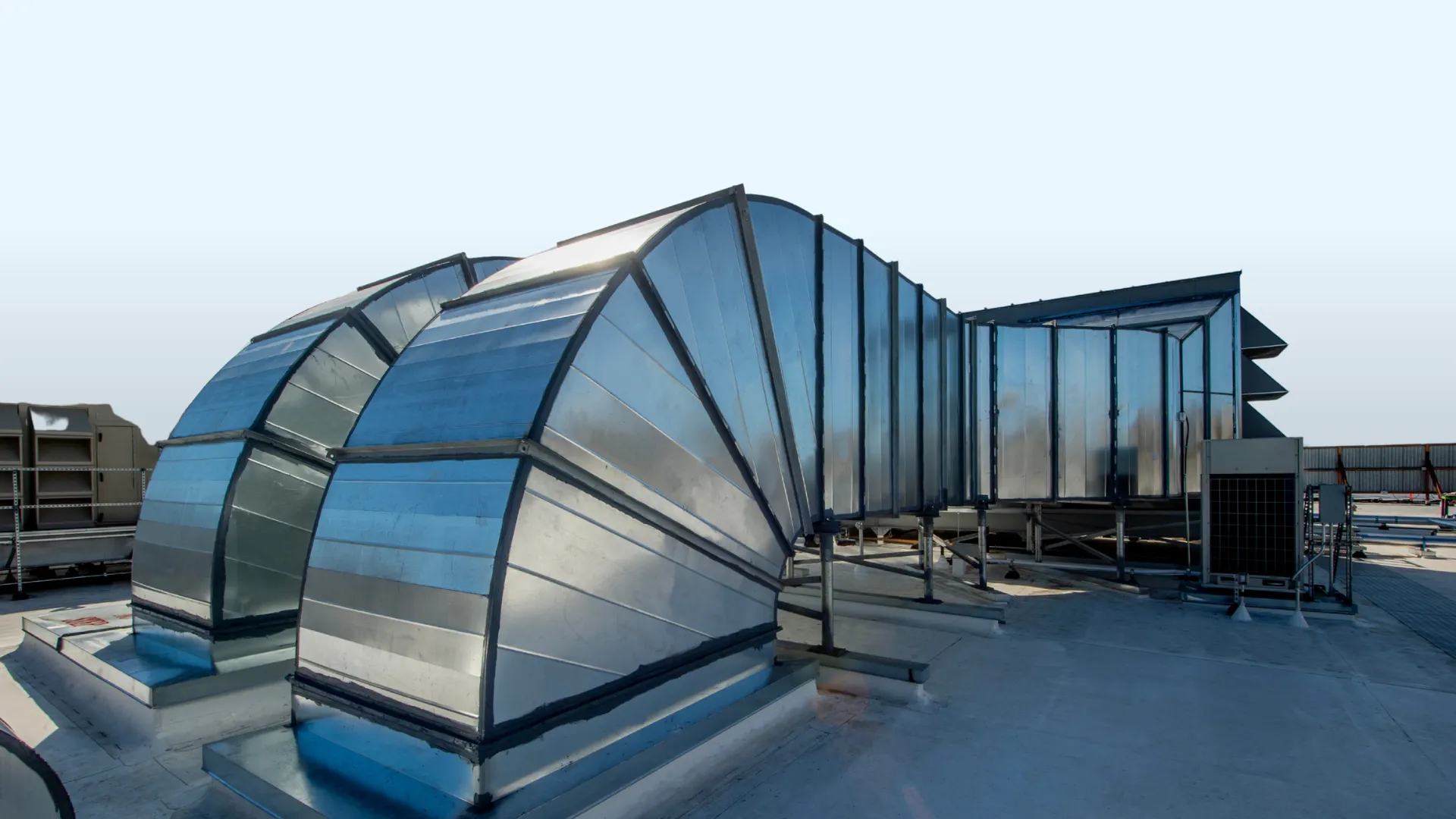
Trakref
How to Prevent HVAC/R Disasters Before They Strike: A Multi-Site Facilities Guide

An HVAC/R crisis can completely derail your operational efficiency.
When refrigeration systems fail at multiple grocery locations during a heat wave, or HVAC units break down across retail stores during peak shopping season, the costs extend far beyond those initial emergency repair bills.
For multi-site operators, HVAC/R management has become a crucial aspect of facilities management. A broken-down HVAC/R system, after all, directly impacts multiple essential areas of your operations: customer experience, regulatory compliance, and operational resilience.
Equipment failures can spoil inventory worth thousands of dollars, trigger regulatory violations, and damage your brand reputation through negative reviews and social media posts. Multi-site facilities teams, in particular, are navigating new challenges all the time: rising refrigerant costs, skilled labor shortages, and increasingly complex regulatory requirements. All of these challenges require innovative, proactive strategies, rather than simple reactive fixes.
Today’s most successful facilities and HVAC/R management professionals aren’t simply managing one crisis after another. They are preventing them!
Through integrated technology platforms, data-driven maintenance strategies, and systematic approaches to vendor management, these organizations are transforming HVAC/R management from a cost center into a competitive advantage.
Why are HVAC/R problems such a big deal for multi-site operators?
HVAC/R problems are an issue no matter where they occur, but they can be especially catastrophic for multi-site organizations. Multi-site facilities professionals often experience HVAC/failures as just one step in a cascade of problems to come.
When systems fail, customers experience uncomfortable shopping conditions, refrigerated products lose integrity, and energy costs spike as remaining equipment works harder to compensate. If one site closes down, the impact can be felt throughout the organization:
- Being forced to focus on an emergency at one site can lead to neglected facilities work at other sites
- A closure at one site can increase demand at another, causing workflow interruptions and delays
- The costs of emergency repairs can force you to delay necessary preventive repairs
Steven Blumenfeld, vice president at Fexa and general manager of Fexa Trakref, explains the fundamental issue: “HVAC and refrigeration is already the most expensive or among the most expensive and impactful categories for facilities leaders. If you look at all of their repair and maintenance spend, this category is often among the top, if not the top category.”
When you run a multi-site operation, the HVAC/R budget is massive. Problems with your HVAC/R system can quickly derail your spending for the quarter or even the year.
Real-world examples of HVAC/R losses
In grocery and retail environments, the consequences prove particularly devastating. Refrigeration failures can result in complete product loss within hours, creating both immediate financial damage and potential food safety issues. If an uninformed consumer witnesses your team discarding damaged food, a simple misunderstanding can turn into public outcry.
For comfort cooling systems in any industry, customer complaints multiply quickly when it’s too hot or too cold. Some facilities have experienced viral social media backlash when store temperatures have become unbearable.
The complexity multiplies when managing dozens or hundreds of locations simultaneously. Whether you’re operating in grocery, retail, or other specialized industries, each site will have its own unique equipment history. Vendor relationships change from site to site, and there are often distinct operating conditions at one site to the next.
The risk of refrigerant loss
HVAC/R failures are typically accompanied by refrigerant loss. These leaks are costly and risky.
Blumenfeld emphasizes that “refrigerant management is all about reducing leaks, and leaks are bad. Leaks are waste, they’re expensive, they lead to downtime. And all of these can have really negative impacts not only on budgets, but also on brand and the customer experience.”
Compliance risks add another layer of complexity. Multi-site operators must track refrigerant usage, leak rates, and maintenance schedules across all locations while adhering to federal regulations. More organizations than ever are falling under regulatory statutes, such as the AIM Act and state-specific requirements like CARB R3. The administrative burden of managing these requirements manually across multiple sites creates significant exposure to violations and penalties.
What are the most common HVAC/R challenges across multiple locations?
Multi-site facilities face recurring HVAC/R challenges that traditional maintenance approaches struggle to address effectively.
These are some of the things that facilities managers understand:
- Refrigerant leaks are costly. Research indicates that a system experiencing a 20% refrigerant leak can increase annual operating costs by 15%, with expenses rising exponentially as leaks worsen.
- Leak detection often happens too late because many facilities rely on reactive approaches–not proactive monitoring. By the time store staff notice temperature fluctuations or higher energy bills, significant refrigerant loss has already occurred. This means you face higher replacement costs and compliance violations.
- Inconsistency in vendor quality creates another major challenge across multiple locations. Multi-site operators typically work with dozens of service providers across different markets, leading to varying service standards, inconsistent documentation practices, and unpredictable response times.
- Aging equipment compounds these problems significantly. Older systems require more frequent maintenance, consume more energy, and often use refrigerants that are being phased out under current regulations
- Rising refrigerant costs create financial pressure across all operations. As HFC production decreases under the AIM Act, prices for common refrigerants have increased dramatically.
- Regulatory thresholds are changing in ways that increase the tracking and reporting burden for most companies. According to Fexa Trakref’s Blumenfeld, “Previously, it was only assets with a 50-pound charge size or greater that were regulated under these regulations. But beginning January 1st, 2026, that threshold goes down to 15. And so now all assets 15 pounds or greater that use an HFC refrigerant are going to fall under the regulated category.”
- Documentation challenges increase exponentially across multiple sites, creating administrative burdens that consume significant time while creating opportunities for errors and oversights.
Because of all of these challenges, facilities teams must maintain comprehensive records for leak inspections, repairs and maintenance activities, refrigerant usage and purchases, disposal activities, and equipment registrations. Without automated systems, this documentation burden creates serious compliance risks.
How can data and automation help prevent HVAC/R emergencies?
Even though HVAC/R problems are daunting, the great news is that they are often preventable. When you have meaningful and actionable data at your fingertips, you can avoid HVAC/R emergencies and the costs that accompany them.
At the cutting edge of proactive HVAC/R management, you’ll find connected systems and intelligent monitoring, as well as automation of burdensome processes. Instead of waiting for equipment to fail so you can repair it, you can use advanced monitoring systems to track performance indicators that will signal problems long before they become emergencies.
This includes:
- Temperature monitoring
- Automated alerts for overheating systems
- Energy consumption tracking
- Refrigerant discharge monitoring
- Automated leak detection systems
- Integrated monitoring systems and work order platforms
The best systems track a wide range of metrics and notify you of potential issues. They also provide you with insights from any past data they have access to. Sophisticated predictive maintenance algorithms can analyze current and historical performance data to identify patterns that your service technicians and facilities team members would never have noticed.
Frank Sullivan from Brainbox AI emphasized how predictive insights helped a client manage refrigeration compliance across 7,000 locations by leveraging technology to identify problems before they affected operations. This proactive approach prevented costly emergency repairs while ensuring regulatory compliance.
Steven Blumenfeld acknowledges both the potential and limitations of emerging technologies: “The proliferation of AI tools is simply amazing. You blink and there’s already a whole new suite of things to learn and things to take advantage of.”
Even so, Blumenfeld emphasizes the critical human element that technology cannot replace: “Every facilities manager knows that at the end of the day, something’s not fixed by AI. Something’s fixed by a person putting their hands on the part that wasn’t working and making it work again.”
Real-time visibility across all locations enables facilities teams to identify systemic issues that affect multiple sites. Rather than treating each location in isolation, data aggregation reveals patterns that inform broader maintenance strategies and vendor performance evaluations.
What best practices keep HVAC/R issues under control across multiple sites?
We have more good news: Successful multi-site HVAC/R management doesn’t require you to run out and get an advanced degree in a new field. It simply requires you to implement consistent approaches that work across all your locations, while still allowing flexibility for local conditions.
Start with your vendors.
Instead of juggling dozens of different service providers, the smartest facilities teams work with fewer, more capable vendors. These vendors can handle multiple trades and deliver consistent service standards. This approach reduces administrative headaches at the same time that it makes it easier to track vendor performance.
Schedule regular check-ins with your vendors. Monthly performance reviews work better than annual meetings for keeping service standards high
Train your retail store staff.
Service providers are essential to any big picture HVAC/R management plan, but you can’t ignore the importance of your on-site retail personnel.
Your location personnel, such as retail store managers, GMs, and full-time maintenance workers, are your first line of defense against HVAC/R catastrophes. When they know how to easily spot early warning signs—unusual noises, temperature changes, or visible refrigerant leaks—problems get addressed before they turn into emergencies.
Steven Blumenfeld points out an important opportunity that comes from regulatory changes: “The AIM Act now gives facilities leaders something external that they can point to that says, ‘Well, you know what? Now there’s a whole new set of reasons and potential penalties that are pushing me to do something that I’ve already wanted to do from a business perspective for a long time.’” This regulatory push lets facilities leaders justify investments they’ve wanted to make anyway.
As Blumenfeld explains, “I recognize that better managing my most critical asset category is going to help me better project my R&M cost needs. It’s going to help me better plan my future capital infrastructure investments.”
Get centralized reporting in place.
Scattered spreadsheets and manual logs are a recipe for disaster. Integrated platforms ensure consistent data collection and analysis across all your locations.
Create standardized maintenance protocols so all locations get consistent service, regardless of which vendor shows up. These should cover:
- What gets inspected and when
- How work gets documented
- When to escalate different types of problems
Plan ahead for equipment replacements. Instead of scrambling when something breaks, schedule upgrades during slow periods to minimize disruption and take advantage of newer, more efficient systems.
Additionally, set up compliance calendars to track regulatory requirements like leak inspections, reporting deadlines, and equipment registrations. With different rules in different states, centralized tracking prevents costly violations.
How does a CMMS with refrigerant tracking help multi-site teams stay ahead?
A modern CMMS provides you with the refrigerant tracking tools you need–and much more. Your facilities team needs access to sophisticated tools that can handle both routine maintenance and emergency response, as well as specialized compliance requirements.
When your CMMS platform is integrated with a dedicated refrigerant tracking system, the results are powerful.
First, consider the impact of automated work orders. Instead of having to keep track of exactly when every HVAC/R system component needs to be serviced, your integrated CMMS and refrigerant management system can automatically dispatch work orders for routine maintenance.
You can also automate:
- Compliance documentation
- Refrigerant tracking reports
- Vendor notifications
- Follow-up tasks
- Condition-specific work orders unique to your equipment
- Other HVAC/R management tasks
Fexa Trakref, which integrates with Fexa’s state-of-the-art CMMS, is the most comprehensive HVAC/R management and refrigerant tracking solution in the industry. Blumenfeld explains, “We cover a broad range of regulations, not only at the federal level, like the AIM Act and the Clean Air Act, but also at the state level.”
The platform handles complex regulatory requirements across different jurisdictions. According to Blumenfeld, “We know that there’s a complex web of state-level regulations from the California Air Resource Board to New York State, Washington State, and others. And so Fexa Trakref is the most comprehensive platform.”
What else happens when you combine your CMMS with refrigerant tracking software?
The benefits continue. Your vendor data gets verified, compliance becomes more manageable, and reporting becomes automated.
This leads to:
- Improved decision-making about service relationships
- Reduced compliance risk
- A smaller administrative burden for facilities managers
- Fewer human errors
- Better documentation across the board
- Faster problem resolution
As Blumenfeld explains, “We know that refrigerant management doesn’t happen in isolation. It’s a critical part of your broader facilities management. It’s a critical part of your broader capital planning, budgeting processes. It’s a critical part of your sustainability reporting and planning.”
Blumenfeld paints the picture of what’s possible: “Imagine a year from now, if you had a single source of truth where you could see every HVAC and refrigeration asset in your portfolio. Then you could know exactly which regulations apply, you could know exactly what the leak rates and performance of those assets are, and you have that single source of truth that you can refer to to actually inform your actions, your planning, and your priorities.”
The Fexa CMMS + Trakref native integration shows how purpose-built solutions address modern facilities challenges. Multi-site operators get comprehensive control over HVAC/R operations while reducing administrative burden and compliance risks. It’s an exciting win for the entire company.
Request a Demo: Fexa x Trakref Integration
Ready to transform your multi-site HVAC/R management strategy? The Fexa CMMS + Trakref native integration provides the comprehensive visibility, automated workflows, refrigerant tracking, and compliance confidence that modern facilities teams need to stay ahead of problems rather than constantly reacting to them.Discover how leading multi-site operators are reducing costs, improving refrigerant tracking compliance, and preventing emergencies through integrated facilities and refrigerant management. Request your demo today.



